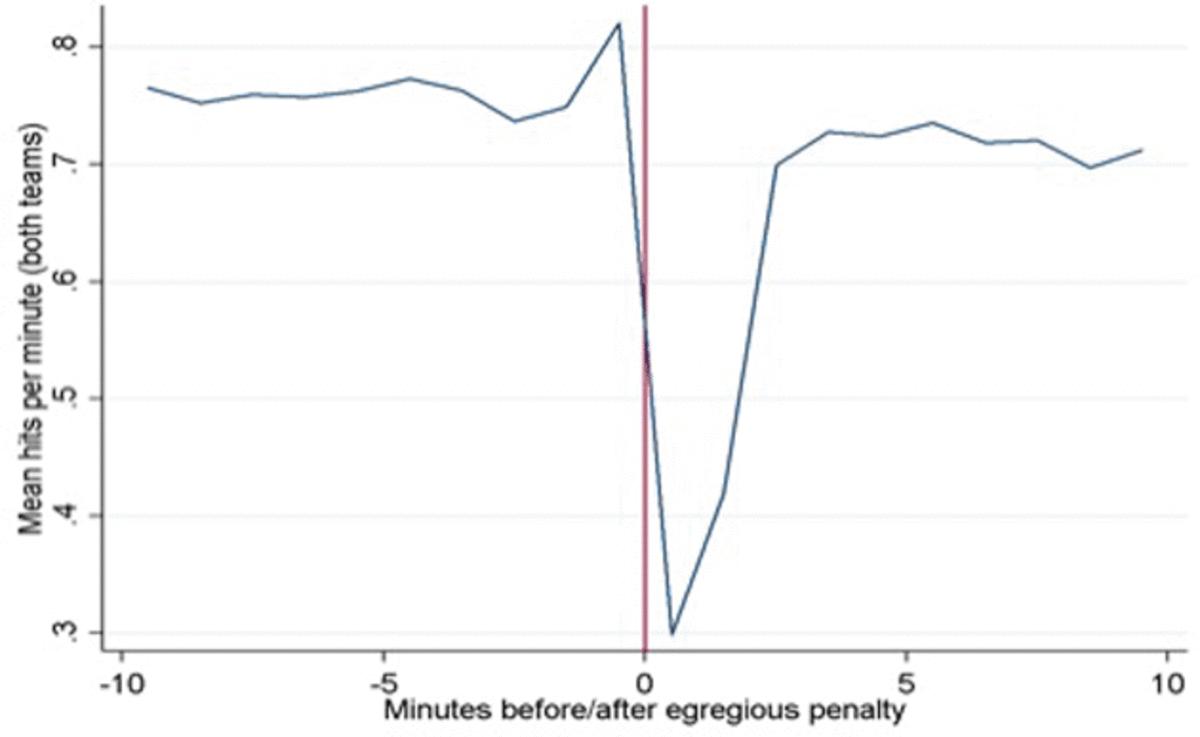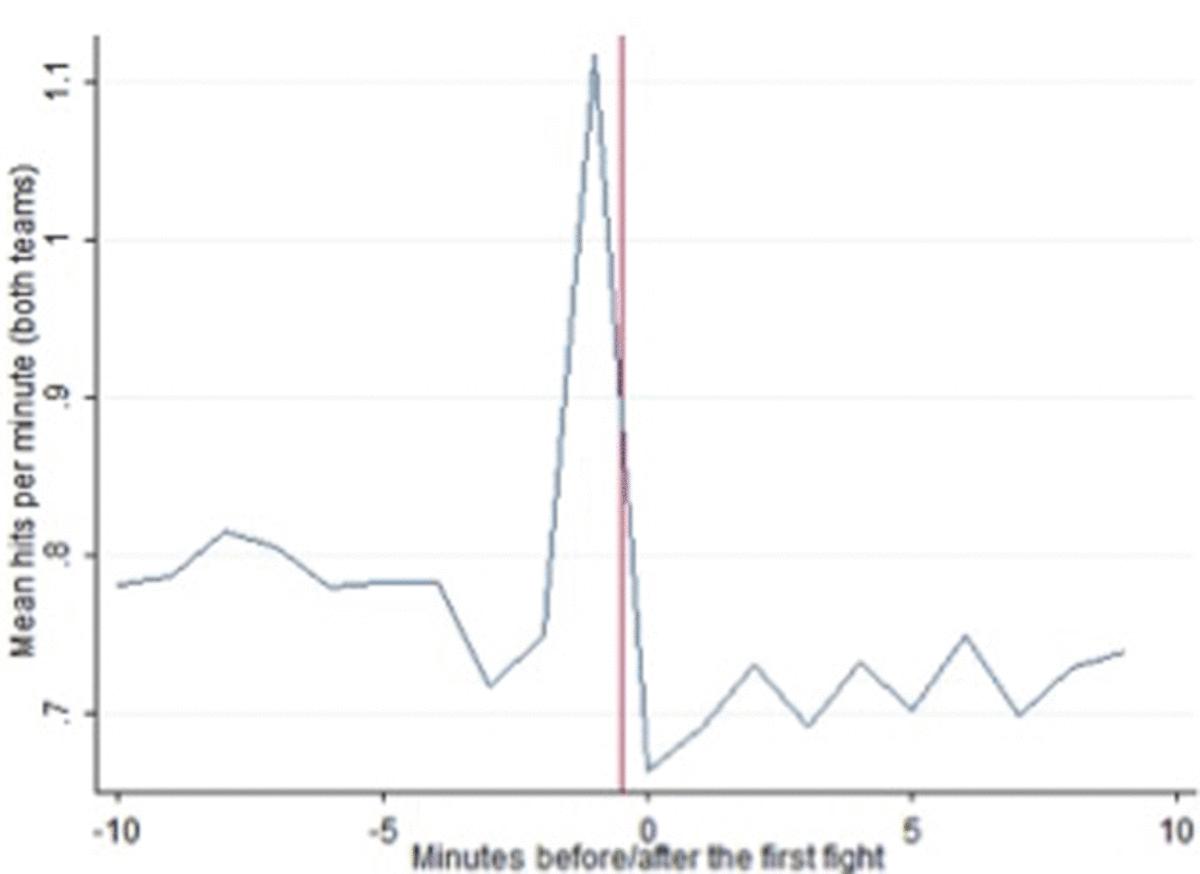What analytics can tell us about the role of fighting in hockey

Get all of The Department of Hockey Analytics' columns as soon as they’re published. Download the new Sports Illustrated app (iOS or Android) and personalize your experience by following your favorite teams and SI writers.
The role of fighting in the game is certainly divisive. On the one hand, new information about the long-term health consequences of head trauma makes it in the interest of players to take it out of the game. On the other hand, proponents of fighting such as Bobby Smith say that so-called “enforcers” act as a form of police on the rink, ensuring that certain liberties aren’t taken with their star players. Without fighting, it is argued, the game gets more violent, leaving players open to even more injuries.
And so it is rather timely that a new study has been released by Greg DeAngelo, Brad Humphreys (both at West Virginia University) and Imke Reimers (at Northeastern University). The authors examine the hypothesis that fighting acts as a deterrent to “bad behavior” on the ice.
Wild on fire, Bruins on the skids, more NHL notes
Of course, the threat of fighting isn’t the only deterrent – penalties also serve as a way to deter dirty play. The hypothesis they examine is that fighting is used as a deterrent specifically when players perceive that referees are not calling penalties, or “letting them play”.
Going to the data to test this hypothesis is not so straightforward. You can’t look for a relationship between called penalties and fights because the hypothesis is that fights break out when a penalty should have been called but wasn’t. But how does one measure penalties not called?
The authors used the NHL’s game sheet data from 2007/08 to 2012/13 to gather information on more than 2 million game events from almost 7,000 games. In that data, they noticed a pattern that often precedes a penalty call – at least a certain kind of penalty. The authors consider an “egregious” penalty to be one that has the potential to cause injury, such as boarding or cross checking. Penalties such as tripping and hooking, on the other hand, are not considered “egregious”. The figure below shows that in the minutes leading up to an “egregious” penalty call, there is often a sustained period of escalated aggressive activity, as measured by hits.

In a normal game state, there are 0.76 hits per minute. In the time leading up to an “egregious” penalty, however, hits increase to just under 0.81 hits per minute. While this difference may seem small, it is statistically significant. After the penalty is assessed, hits drop by quite a large amount (there aren’t many hits on a power play), but stay at a very low level until about 3.5 minutes after the penalty call, at which point they return to the normal game state level. In other words, when a penalty is called, the ensuing power play, coupled with the message that the officials are not keeping their whistles in their pockets, calms down physical play that might otherwise escalate.
There are periods, however, where this period of escalated hits goes on without a penalty call. In these situations, we observe a real spike in hits to over 1.1 per minute, and then a fight. After the fight, hits drop down to a normal game state level. In this respect, Smith and the other proponents of fighting appear to be right: in the absence of the fight there’s good reason to expect the violence would escalate, thereby increasing the risk of injury.

One of the implications of these findings is that penalties and fights are substitutes for each other in that both are capable of deterring undesirable behavior on the ice. This seems like an obvious conclusion, and yet the proponents of keeping fighting in the game somehow seem to neglect it.
In effect, proponents of fighting ignore the benefits of better officiating in games that become dangerously physical while those calling for the removal of fighting have failed to give this form of vigilante justice its due as a deterrent against other – potentially catastrophic – injuries when those responsible for policing the game fail to do so.
What’s clear from the research is that if any league were to try to take fighting out of the game and make no other changes, it would mean that we should expect the game to be rougher, and perhaps more dangerous, as Smith suggests. However, it should be possible to offset this change by having referees call games more tightly, at least with regards to these “egregious” penalties. If referees can resist the urge to “put their whistles away and let the players decide the game”, especially when the play starts getting “chippy”, then players won’t have to resort to fighting.
While this will undoubtedly have the effect of more penalties being called, which some might not like, it would also reduce the need for players to police the game themselves. Of course, the extent to which the referees are able to do this depends in large part on whether players can hide their bad behavior from the sightlines of the refs.
The X factors in NHL analytics
There is, of course, a third form of deterrence, namely, suspensions and fines that occur after the fact. Currently, any discussion about how to take fighting out of the game focuses on making fighters subject to suspensions. The findings of this paper, however, imply that there should be more focus on suspensions and fines for “egregious” penalties. Specifically, if players are deemed to be going out of their way to commit penalties while hiding them from the refs, then they should be hit with fairly hefty sanctions coming from the Department of Player Safety. This, perhaps more than suspensions for fighting itself, could have a dramatic impact on the number of fights. After all, it is the need to police the game that causes the fights in the first place. Take away the need, and it becomes that much easier to take fighting out of the game.
Bobby Smith is an intelligent guy with decades of experience as a player, owner, GM and coach at multiple levels. The fact that he was a power forward who combined skill, toughness, and a willingness to drop the gloves makes one believe he’s even handed in his views on the subject and someone whose opinions should be taken seriously.
But like many of the other proponents of fighting in hockey, Smith seems to be leaving a compelling argument for stricter officiating on the table.
The Department of Hockey Analytics employs advanced statistical methods and innovative approaches to better understand the game of hockey. Its three founders are Ian Cooper, a lawyer, former player agent and Wharton Business School graduate; Dr. Phil Curry, a professor of economics at the University of Waterloo; and IJay Palansky, a litigator at the law firm of Armstrong Teasdale, former high-stakes professional poker player, and Harvard Law School graduate. Greg DeAngelo is a professor of economics at West Virginia University. Visit us on line at www.depthockeyanalytics.com
